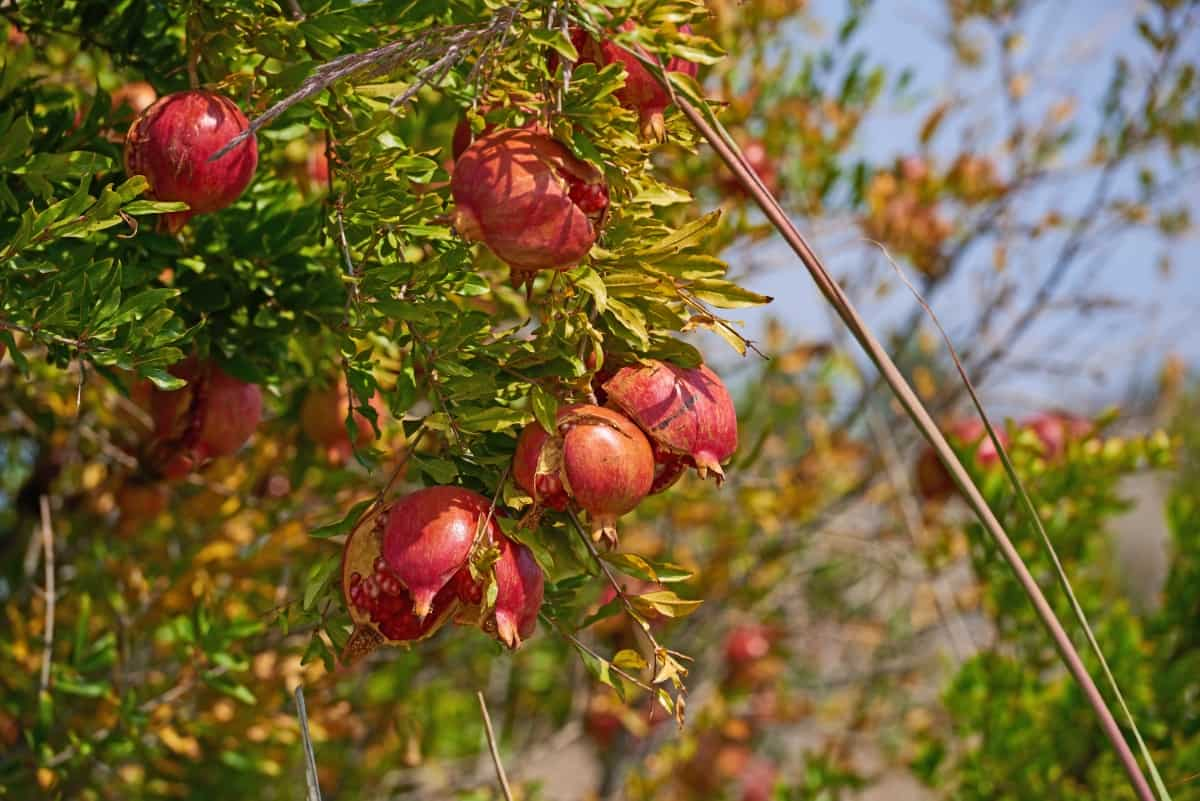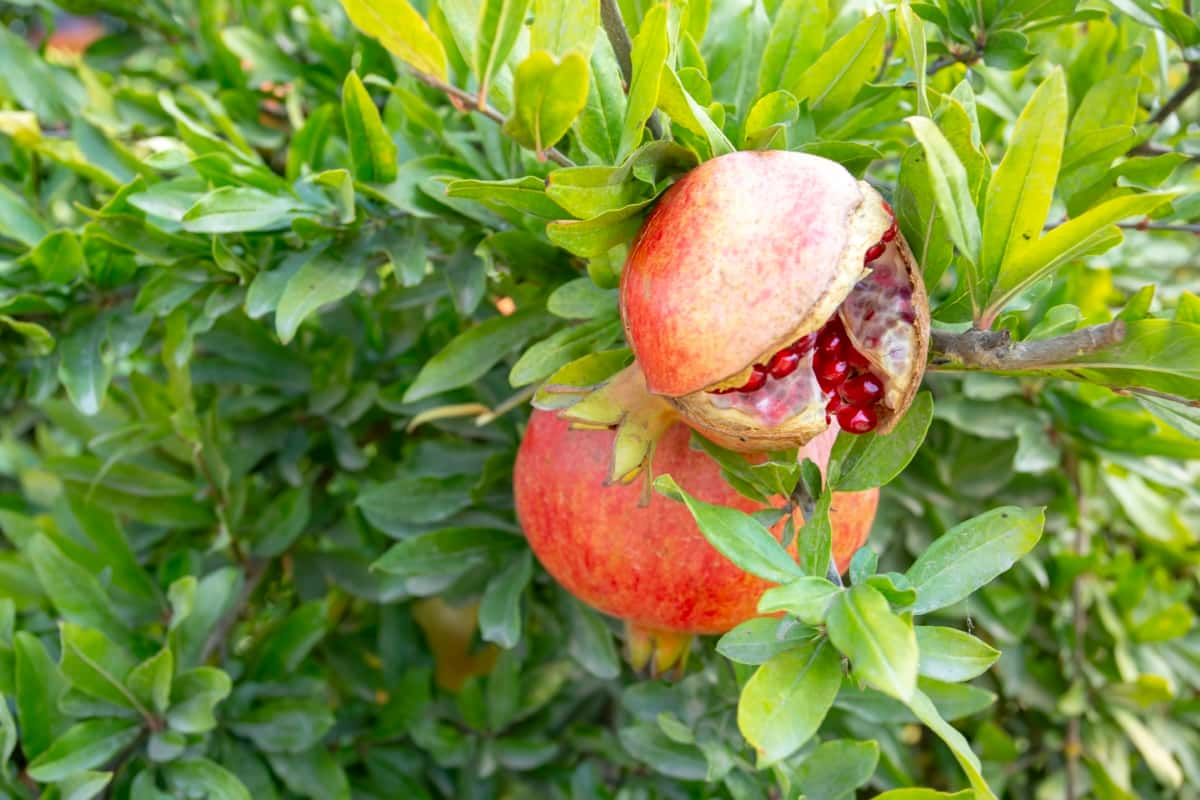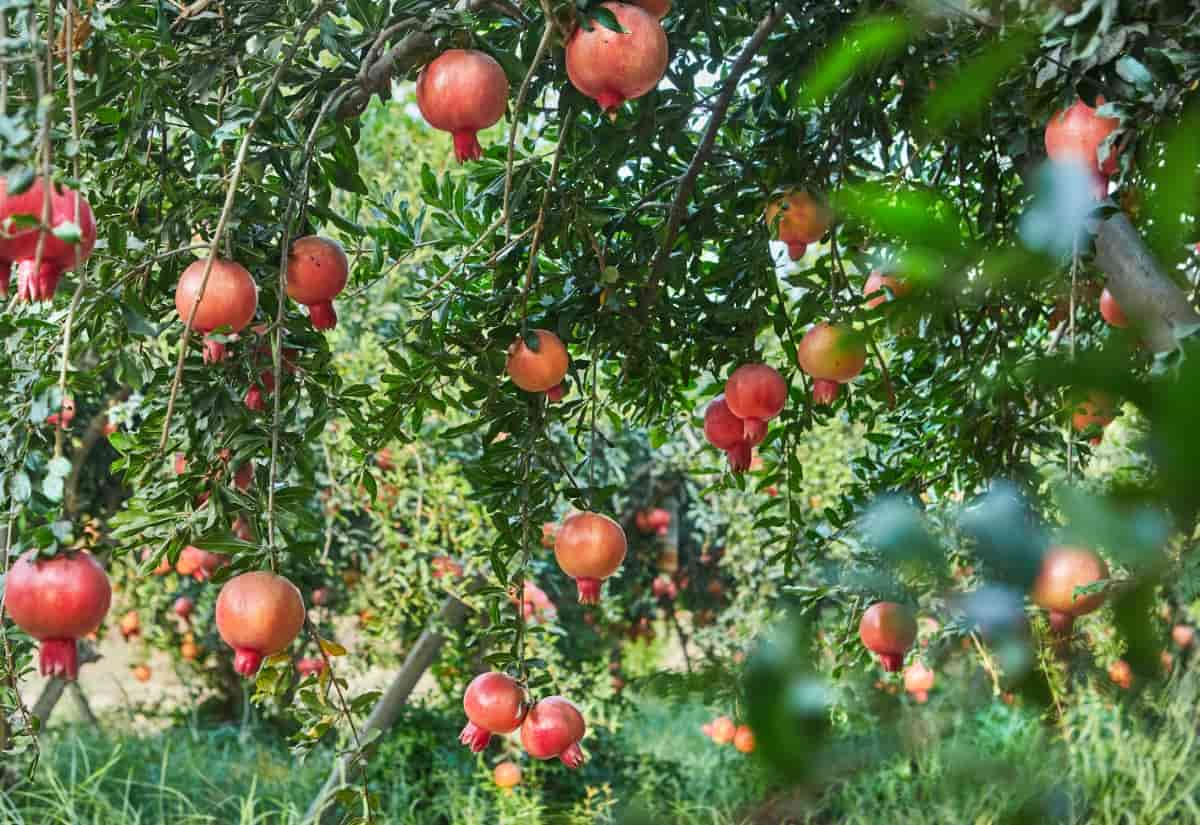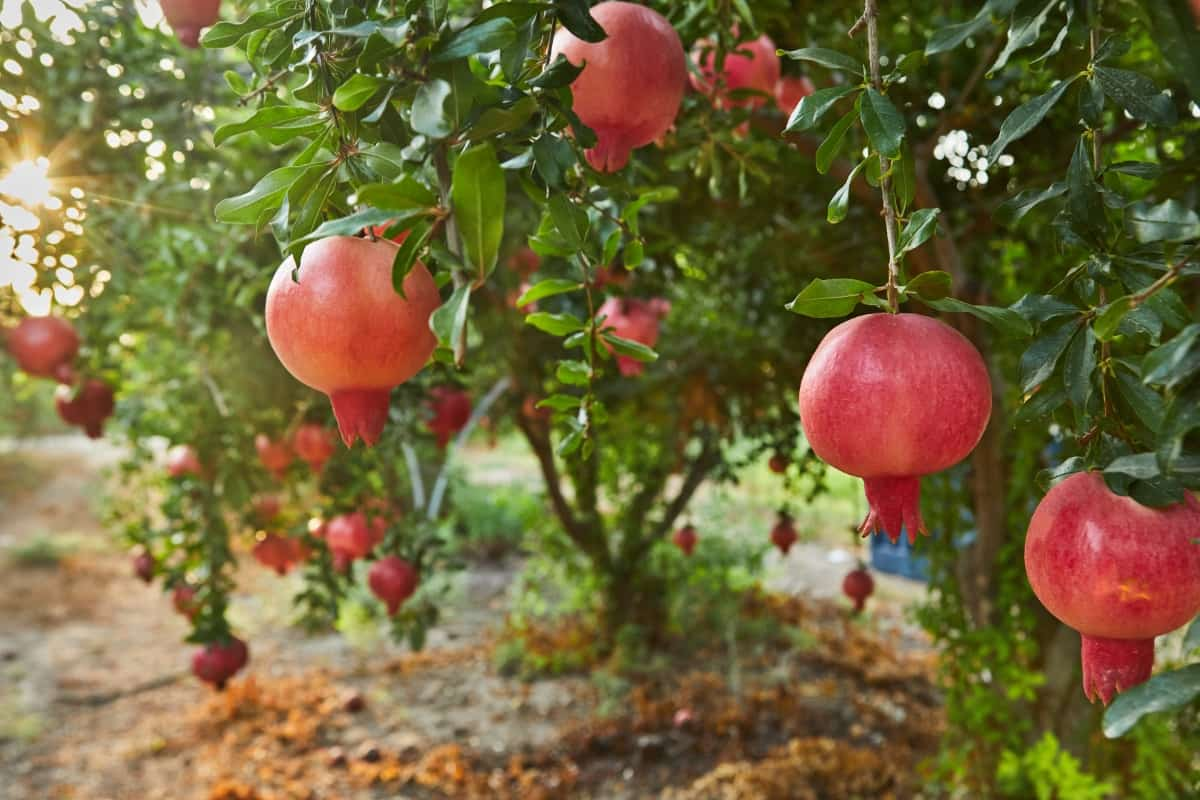Enhance your pomegranate orchard’s resilience with strategic management of Bacterial Blight. Recognize symptoms and comprehend the disease cycle for proactive intervention. Implement effective chemical treatments while exploring biological controls for sustainable disease management.

Identify resistant pomegranate varieties to bolster your defense. Embrace an integrated disease management approach, harmonizing various strategies. This guide empowers growers with precise insights, ensuring optimal control measures against Pomegranate Bacterial Blight.
Bacterial Blight in Pomegranates
Introduction to Bacterial Blight in Pomegranates
Pomegranate (Punica granatum L.) is a valuable fruit crop that is cultivated in many tropical, subtropical areas of the world. It is rich in antioxidants, vitamins, minerals, phytochemicals that have various health benefits. However, pomegranate production is threatened by several biotic and abiotic factors, among which bacterial blight is one of the most serious diseases. Bacterial blight causes severe losses in fruit yield and quality and can also affect the longevity of the orchards.
Bacterial blight disease reduces the production of fruit by 30 to 50%. Pomegranate disease is triggered by the bacterial pathogen Xanthomonas axonopodis pv. punicae (Xap). The pathogen enters the plant through wounds and stomata and infects the leaves, stems, and fruits. High temperatures, high humidity, and rainfall favor the disease. The disease can spread rapidly through wind, rain, insects, pruning tools, and infected plant material.
Impact on Pomegranate Cultivation
Bacterial blight has a negative impact on pomegranate cultivation in terms of yield, quality, and profitability. The disease reduces the fruit’s size, weight, and color and makes them unmarketable. The infected fruits may also drop prematurely or rot on the tree. The disease also affects the vegetative growth of the plants, resulting in reduced flowering and fruiting. The disease can also cause dieback of branches and cankers on stems, which may lead to the death of the plants. The disease can also reduce the shelf life of the fruits and increase post-harvest losses.
Causative Agent of Bacterial Blight
The causative agent of bacterial blight is Xanthomonas axonopodis pv. punicae (Xap), a gram-negative, rod-shaped, aerobic bacterium that belongs to the family Xanthomonadaceae. Xap is a host-specific pathogen that infects only pomegranate and its wild relatives. Xap has a circular, single-stranded DNA genome of about 5 Mb, which encodes for various virulence factors such as type III secretion system, extracellular polysaccharides, lipopolysaccharides, flagella, pili, and effector proteins.
Identifying the Pathogen
Xap can be identified through various methods, including morphological, biochemical, serological, molecular, and pathogenicity tests. Morphological characteristics include yellow mucoid colonies on nutrient agar plates, rod-shaped cells with polar flagella, and positive reactions for oxidase, catalase, starch hydrolysis, and nitrate reduction tests. Biochemical characteristics include positive reactions for glucose fermentation, arginine dihydrolase, levan production, and indole production. Serological characteristics involve positive reactions for agglutination with specific antibodies. Pathogenicity tests involve inoculation of healthy pomegranate plants with bacterial suspensions.
In case you missed it: How to Control Pomegranate Pests Naturally: How to Get Rid of Them with Natural and Organic Treatment

Symptoms and Disease Progression
Bacterial blight is a disease that affects young plants during spring and summer, causing water-soaked lesions on leaves, shoots, and fruits. These lesions can cause wilting, curling, and premature leaf drop. Shoots may experience dieback or canker formation due to the lesions. Fruits may show dark brown spots with hollow centers, cracking or oozing bacterial ooze, and internal rotting or discoloration of the pulp. The disease progresses rapidly, causing significant losses in a short period.
Early Detection and Diagnosis
- Initial symptoms resemble other diseases or disorders.
- Reliable confirmation through morphological, biochemical, serological, or molecular tests.
- Water-soaked lesions on leaf margins or tips with enlarging brown spots and yellow halos.
- Visible in spring and summer, especially in high-temperature, high-humidity conditions.
Advanced Symptoms and Plant Damage
- More severe and noticeable than initial symptoms.
- Includes wilting, curling, and dropping of leaves, dieback, canker formation, and dark brown spots on fruits.
- Bacterial ooze, internal rotting, and reduced fruit size, weight, and color.
- Occurs in late summer and autumn, with moderate temperature and humidity and scarce rainfall.
- This leads to reduced yield and fruit quality, increased post-harvest losses, stunted plant growth, and heightened susceptibility to other pests and diseases.
Epidemiology of the Disease
The epidemiology of bacterial blight focuses on the factors influencing its occurrence, spread, and severity. These include the host, the pathogen, and the environment. The host factors include pomegranate cultivars’ susceptibility to Xap infection, while the pathogen factors include Xap strains’ virulence and genetic diversity. Environmental factors like temperature, humidity, rainfall, wind, irrigation, soil type, and pH also impact the disease’s spread.
Biological Characteristics of the Bacteria
The biological characteristics of Xap include its survival, dissemination, and infection strategies. Xap can survive in soil, water, plant debris, and seeds for several months or years under favorable conditions. Xap can disseminate through wind-driven rain, irrigation water, insects, pruning tools and infected plant material. Xap can infect pomegranate plants through natural openings such as stomata or wounds caused by insects or mechanical injuries. Xap can colonize the intercellular spaces of the plant tissues and secrete various enzymes and toxins that cause tissue necrosis and wilting.
Cultural Management Practices
Cultural management practices aim to reduce the inoculum source, prevent Xap dissemination, and enhance pomegranate plant resistance to bacterial blight. These practices include:
- Selecting healthy planting material from certified nurseries
- Avoiding low-lying or poorly drained areas
- Maintaining optimal plant spacing and pruning
- Removing and destroying infected parts or fruits
- Disinfecting pruning tools
- Using drip irrigation or furrow irrigation
- Applying balanced fertilizers according to soil test results
- Using organic mulches like straw, bark, or compost
- Rotating pomegranate with non-host crops to break the disease cycle.
- These practices ensure adequate light penetration and air circulation, minimize water contact with plant parts, and maintain plant health. By following these practices, pomegranate plants can be more resistant to bacterial blight.
Chemical Control Measures
Chemical control measures are the measures that involve the use of chemical agents such as bactericides or antibiotics to kill or inhibit Xap. Chemical control measures can be used as a supplement to cultural control measures when the disease pressure is high or when other methods are not effective. Some of the chemical control measures that can be used to control bacterial blight are:
- Spraying copper-based bactericides such as copper hydroxide, copper oxychloride or copper sulfate at recommended doses and intervals to reduce Xap population on plant surfaces.
- Spraying antibiotics such as streptomycin sulfate or oxytetracycline hydrochloride at recommended doses and intervals to inhibit Xap growth in plant tissues.
- Spraying plant activators such as acibenzolar-S-methyl or salicylic acid at recommended doses and intervals to induce systemic acquired resistance in pomegranate plants.
- Spraying biocontrol agents such as Bacillus subtilis or Pseudomonas fluorescens at recommended doses and intervals to compete with or antagonize Xap.
Biological Control Strategies
Applying biocontrol agents like Bacillus subtilis, Pseudomonas fluorescence, and Trichoderma harzianum can help reduce the population and activity of the pathogen. Used and applied as seed treatments, soil amendments, or foliar sprays.
Use of Resistant Varieties
Selecting and planting varieties that are resistant or tolerant to bacterial blight can reduce the incidence and severity of the disease. Some of the resistant varieties are Ganesh, Bhagwa, Ruby and Arakta.
In case you missed it: How to Control Okra Bacterial Wilt Naturally: How to Get Rid of This with Natural and Organic Treatment

Integrated Disease Management
Cultural Practices
Using healthy and disease-free planting material, avoiding overhead irrigation, maintaining proper spacing and pruning, removing and destroying infected plant parts and debris, and following crop rotation can help prevent or minimize the infection and spread of bacterial blight.
Chemical Control
Spraying the crop with streptocycline (500 ppm) or bronopol (500 ppm) + copper oxychloride (0.2%) can effectively control bacterial blight. These chemicals should be applied at the first sign of infection and repeated at 10-15 days intervals. Bordeaux mixture (1%) can also be used as a preventive measure.
In case you missed it: Bacterial Wilt Management in Eggplant (Brinjal): Symptoms, Treatment, Chemical, Biological, Natural, and Organic Control

Conclusion
Proactive management of Bacterial Blight in pomegranates is imperative. Early detection through reliable testing is key. Implementing effective control measures in response to initial symptoms is vital to mitigate advanced damage, ensuring a resilient and productive orchard.
- Beneficial Insects in Pest Management
- Natural Solutions for Pest Control in Flower Gardens
- Types of Fungicides Used in Agriculture
- Common Issues in the Fruit Development Stage of Pomegranate Farming
- Fruit Development Issues in Papaya: Easy Solutions and Treatment
- Soil-Borne Diseases and How to Protect Your Plants
- Practices to Prevent Disease Spread in the Garden
- From Wilted to Thriving: How to Treat Root Rot Naturally in Houseplants
- Natural Remedies to Cure Brown Spots on Fig Tree Leaves